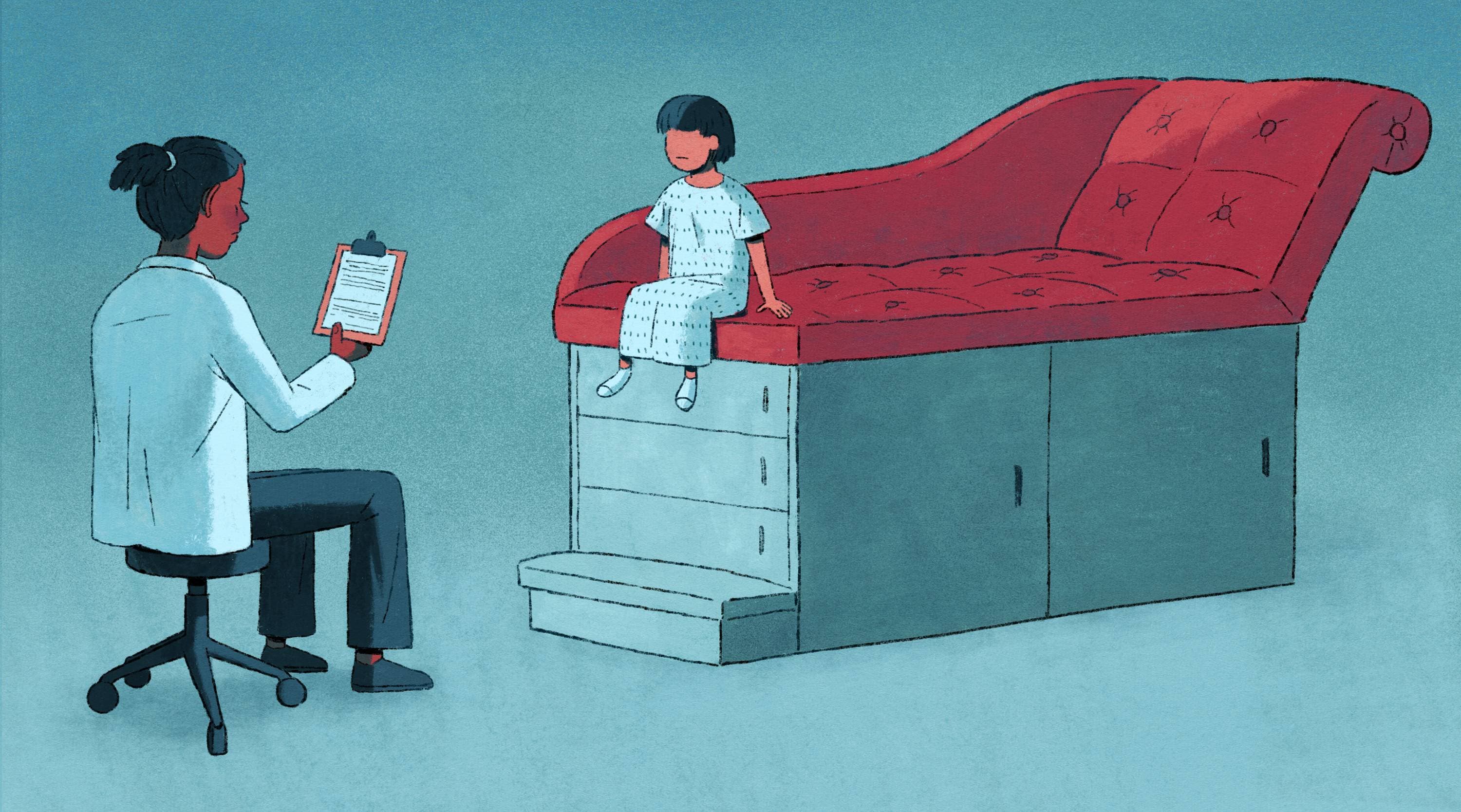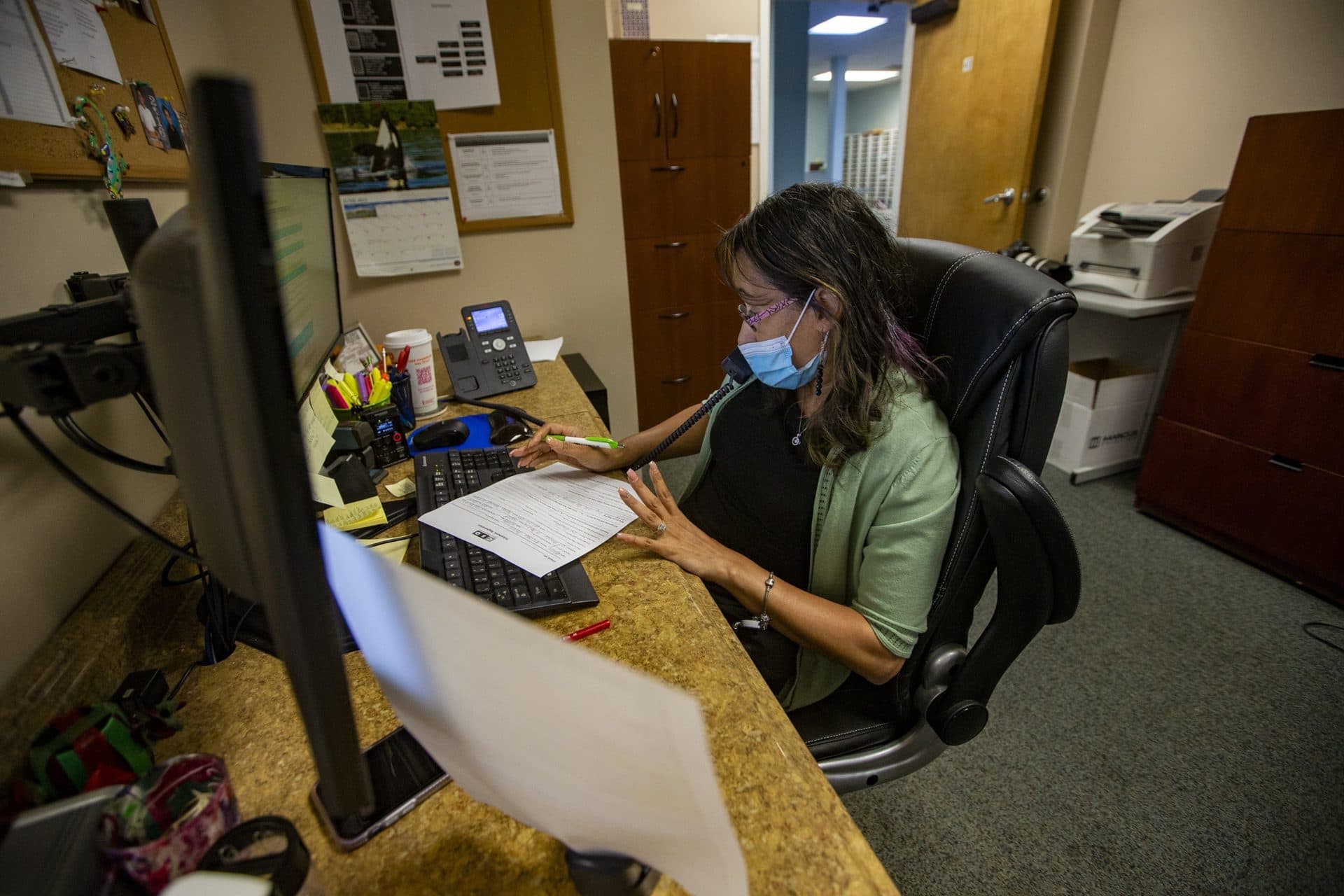
Wait Lists For Children's Mental Health Services Ballooned During COVID
Early last year, as the coronavirus threat spread, a 9-year-old named Miles turned into a raging boy his parents did not recognize. The family pediatrician referred Miles to a therapist. His mom, Emily Johnson, says her son needed help right away, but the earliest appointment was one to two months away.
Three weeks after seeing the pediatrician, Miles was in a hospital emergency room. It would be the first of six trips to an ER over the next four months.
“It’s a nightmare to be asking for help and not be able to access the help,” says Johnson, who lives on Cape Cod. “It feels frightening, it feels isolating, and it feels devastating.”
Miles is stable now. But the predicament for many children seeking care is worse. At one Boston hospital, the wait for every type of mental health care is six to 12 months.
That’s not soon enough for children who can’t sleep, who say there’s no reason to get up in the morning, or who have stopped eating. So parents are putting their kids on multiple waiting lists. They’re paying cash rather than holding out for therapists who take their insurance. Many are becoming more anxious or depressed themselves.
“It’s a nightmare to be asking for help and not be able to access the help. It feels frightening, it feels isolating, and it feels devastating.”
Emily Johnson
There are a few places in Massachusetts that could become models for a way out of the nightmare Johnson and her son experienced. One is a Springfield clinic run by the nonprofit Clinical and Support Options (CSO).
Anyone can call or walk into this nondescript brick office block and spend 20 minutes to an hour talking to a counselor who is standing by, waiting for new clients. The social worker or psychologist makes an initial assessment, crafts a treatment plan and books the next appointment. Karen Poisson, senior vice president of programs at CSO, says this on-call therapist who can also manage details like insurance coverage and which providers are available to treat the patient, is the key.
“That’s where we’re unique, is that we have this position,” Poisson says.
CSO offers a range of mental health care options. Weekly therapy is enough for some clients. Others need in-home visits, sessions with a therapeutic mentor, family support, group counseling, or a psychiatrist. If the person who walks in or calls is out of control, the on-call therapist contacts a crisis intervention team.
“We don’t want families to have to figure out what they need,” says Karin Jeffers, CSO’s president and CEO. “That’s our job.”
CSO operates six walk-in behavioral health clinics and four sites for emergency care that cover much of north central and western Massachusetts. The agency serves 19,000 clients, about 25% of which are children. What’s covered depends on the patient’s insurance plan.
CSO says everyone can get some level of care right away, like the option to join a group. The wait for individual therapy might be a few days, a week, or longer for patients who don’t want virtual visits or prefer a therapist of a specific age, gender, race or ethnicity.

Demand for mental health care is up at CSO during the pandemic, by about 20%. The increased demand is leading to long wait times at other area agencies. Charles, a father of four, discovered that last summer when his son Charlie was acting out. We’re not using the family’s last name to keep the children’s mental health history private.
At the first clinic he called, Charles was told it would take a month or two before his son could be seen. But after he contacted CSO, Charlie got an appointment in just one week.


“It was a relief, with their background and everything, it was a huge help, a huge relief,” the father says.
Charles had recently regained custody of his children from the foster care system. Once the family coordinated with CSO, Charlie, now 12, had weekly counseling sessions for about nine months, focused on the trauma of being in foster care and separation from his mom.
“It felt nice just to have someone to talk to about, kind of, well, a lot of anger management,” Charlie says, “about my mother and what happened.”
Charlie sees his therapist monthly now. At CSO, managers review patient’s ’progress weekly, moving them to more or less intense services to make room for new clients. The agency started this treatment-on-demand model seven years ago amid frustration about long waits for kids, problems referring them for other services and no-show appointments.
“Quite frankly, we just said, ‘there’s got to be a better way,’ ” Jeffers says. “You know, if I had a child and needed him to be seen for an earache and my doctor said, ‘You have to come back in three weeks,’ that wouldn’t be acceptable. So why was that acceptable in the behavioral health space?”
Jeffers says the change has been good for patients and for CSO. No-shows are way down. Both patient volume and revenue are up. But this model is fragile. It’s hard to attract and retain qualified employees in rural areas, especially during the pandemic when employees with children have cut hours and asked to work from home, Jeffers says. The main problem is low pay.
Data collected by a statewide trade association show social workers at CSO and other community mental health agencies make $15,000 to $20,000 less a year than employees doing the same jobs at state agencies or hospitals. For psychiatrists, Jeffers says the insurance reimbursement gap rises to $50,000 a year or more.
The result: young clinicians come to CSO or another community mental health agency for on-the-job training, stay for a couple of years and move on to jobs with higher pay.
“The rates that we’re reimbursed by insurance companies are just not high enough,” Jeffers says.
"You know, if I had a child and needed him to be seen for an earache and my doctor said, ‘you have to come back in three weeks,’ that wouldn’t be acceptable. So why was that acceptable in the behavioral health space?"
Karin Jeffers
Salaries at CSO would be even lower if not for an additional million dollars the agency received this year from a federal pilot program working to expand community-based mental health services. The grant ends next year, however, and Jeffers’ hopes are pinned on a mental health “Roadmap” proposed by Gov. Charlie Baker that promises to increase reimbursement rates.
“If that [federal] money goes away, and the Roadmap doesn’t kind of pick up the sustainability piece, it would really throw the system into crisis for us,” Jeffers says.
That Roadmap envisions centers like CSO across the state. And it spells out a second route to immediate mental health care — this one directly from a child’s family doctor or pediatrician. But many doctors, nurses and physician assistants aren’t taught how to diagnose and treat mental illnesses. Long before COVID, the state set up a helpline to connect pediatricians trying to address an influx of children with mental health issues to child psychiatrists. It’s getting a lot of use lately.
Demand “has gone out of sight,” says Dr. John Straus, director of the Massachusetts Child Psychiatry Access Program, which operates the helpline. “Utilization from before the pandemic is up 34%.”
A few larger pediatric practices are building mental health care into their offices, adding counselors, community health workers and affiliations with psychiatrists. Boston Medical Center is bringing that model to seven community health centers in low-income neighborhoods, where mental health care can be particularly scarce.
Dr. Michelle Durham, a BMC psychiatrist, runs a grant-funded program that helps train staff for this model. Her program includes consulting on specific cases, help managing treatment for some children and online tutorials about common ailments.
“What is depression, what does that look like in a child, what are some of the interventions and is this kid, is this adolescent getting better?” Durham explains. “We’re teaching to all of that.”
Now, almost seven years into this project, Durham says there are no wait times for basic mental health care at these seven health centers. She agrees with the governor’s proposal that mild to moderate mental health issues can be managed by a pediatrician or other primary care provider, just like diabetes or other chronic conditions.
“We know that we don’t have enough mental health specialists in the field, we just don’t,” Durham says. “But we know primary care doctors are seeing these kids. Depression, anxiety, ADHD are just par for the course. And so we have to have a new model of care.”
Durham says that’s become even more evident during the pandemic.
"... We know primary care doctors are seeing these kids. Depression, anxiety, ADHD are just par for the course. And so we have to have a new model of care."
Dr. Michelle Durham
The state of mental health care is better in Massachusetts than in almost every other state. But Lydia Conley, president and CEO of the Association for Behavioral Healthcare, says that doesn’t mean it is good enough.
“The majority of youth with depression, for example, almost 55%, did not receive any mental health treatment [in 2020],” she says. “It really does come down to a workforce, payment and wage issue.”
One reason why so many kids and teens don’t receive care is that many people are embarrassed or reluctant to seek mental health treatment. But another factor is the need for more professionals trained to enter the field.
Many people decide against careers in mental health. Salaries for social workers who often carry both undergraduate and graduate school debt can be under $40,000. Psychologists and psychiatrists who require more years of training accumulate more debt. The state has a loan repayment program for clinicians who agree to work in community settings, but clinic directors say it isn’t high enough to offset the salary difference for psychiatrists and some other professionals.
Many clinicians warn prospective colleagues about time wasted on onerous licensing rules, insurance paperwork and other obstacles to helping people. Those burdens help explain why a growing number of clinicians have switched to just taking cash over insurance — and why demand for all levels of mental health care is much stronger than supply.
Johnson, the mom whose son was in and out of an ER last spring, has some guidance for parents or guardians frustrated because they can’t find help for their children.
“The first thing is to make sure that you are taking care of yourself,” she says. “Start building a support team. And do not be afraid to speak out early and often.”
That social support might be more vital than ever as the state and providers work on models for faster, easier to access care.
This project is funded in part by a grant from the NIHCM Foundation. Illustrations and animations in this series were created by Sophie Morse.
This segment aired on June 22, 2021.
